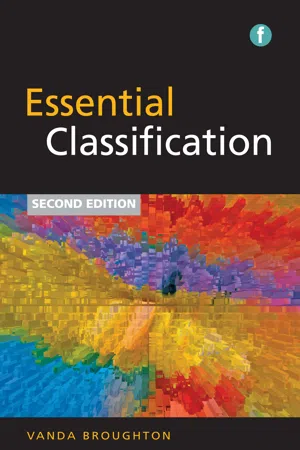Essential Classification
About this book
Classification is a crucial skill for all information workers involved in organizing collections. This new edition offers fully revised and updated guidance on how to go about classifying a document from scratch. Essential Classification leads the novice classifier step by step through the basics of subject cataloguing, with an emphasis on practical document analysis and classification. It deals with fundamental questions of the purpose of classification in different situations, and the needs and expectations of end users. The reader is introduced to the ways in which document content can be assessed, and how this can best be expressed for translation into the language of specific indexing and classification systems. Fully updated to reflect changes to the major general schemes (Library of Congress, LCSH, Dewey and UDC) since the first edition, and with new chapters on working with informal classification, from folksonomies to tagging and social media, this new edition will set cataloguers on the right path. Key areas covered are: the need for classification, the variety of classification, the structure of classification, working with informal classification, management aspects of classification, and classification in digital space. This guide is essential reading for library school students, novice cataloguers and all information workers who need to classify but have not formally been taught how. It also offers practical guidance to computer scientists, internet and intranet managers, and all others concerned with the design and maintenance of subject tools.
Frequently asked questions
- Essential is ideal for learners and professionals who enjoy exploring a wide range of subjects. Access the Essential Library with 800,000+ trusted titles and best-sellers across business, personal growth, and the humanities. Includes unlimited reading time and Standard Read Aloud voice.
- Complete: Perfect for advanced learners and researchers needing full, unrestricted access. Unlock 1.4M+ books across hundreds of subjects, including academic and specialized titles. The Complete Plan also includes advanced features like Premium Read Aloud and Research Assistant.
Please note we cannot support devices running on iOS 13 and Android 7 or earlier. Learn more about using the app.
Information
Table of contents
- Title Page
- Contents
- Acknowledgements
- 1. Introduction
- 2. The need for classification
- 3. First principles of classification
- 4. The variety of classification: systems and structures
- 5. The classification scheme: internal structure
- 6. Types of classification scheme
- 7. Order in the classification scheme
- 8. Content analysis 1: document description
- 9. Content analysis 2: practical constraints
- 10. Controlled indexing languages
- 11. Word-based approaches to retrieval
- 12. Library of Congress Subject Headings 1: basic headings
- 13. Library of Congress Subject Headings 2: structured headings
- 14. Classification scheme application
- 15. Library of Congress Classification 1: basic classmark construction
- 16. Library of Congress Classification 2: use of tables
- 17. Dewey Decimal Classification 1: general properties and basic numbers
- 18. Dewey Decimal Classification 2: number building
- 19. Universal Decimal Classification 1: general properties and basic number building
- 20. Universal Decimal Classification 2: auxiliary tables
- 21. Faceted classification
- 22. Managing classification
- 23. Classification in digital space
- Glossary
- Bibliography and further reading
- Index
